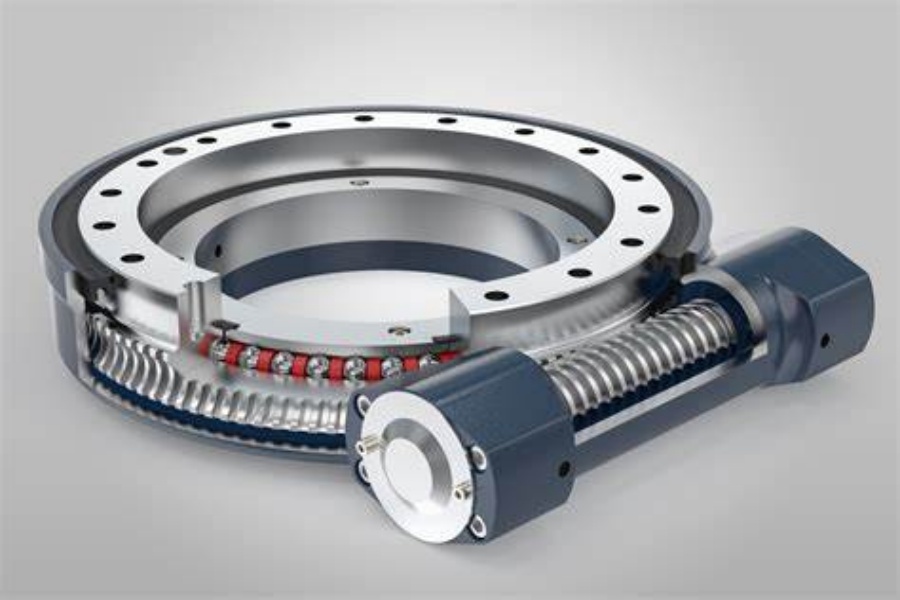
Mastering Motion Control with Worm Gear Slew Drives
In the realm of heavy machinery and precision engineering, where controlled rotation under load defines operational success, the Worm Gear Slew Drive emerges as a cornerstone technology. These drives excel in scenarios demanding smooth, reliable rotational movement combined with self-locking security—whether orienting solar panels toward the sun, positioning radar antennas, or rotating industrial mixers. This article explores how the Worm Gear Slew Drive redefines motion control through its unique mechanical advantages, adaptability, and unwavering performance across diverse applications.
What is a Worm Gear Slew Drive?
A Worm Gear Slew Drive is a compact rotational transmission system that combines a worm gear mechanism with a slewing ring bearing to deliver controlled, high-torque rotation. The system features a threaded worm shaft that meshes with a toothed wheel (worm wheel) integrated into the slewing ring. This configuration provides inherent self-locking capabilities, meaning the system cannot be back-driven—a critical safety feature when holding heavy loads in position. Designed for applications requiring precise angular adjustments under substantial weight, such as satellite dish positioning, crane booms, or solar tracker systems, these drives prioritize reliability, shock resistance, and low-maintenance operation. Their ability to achieve high reduction ratios in minimal space makes them ideal for industries where efficiency and safety coexist as non-negotiable priorities.
How the Worm Gear Slew Drive Operates
Imagine a scenario where a massive industrial mixer must rotate at precise intervals to blend materials without slipping, or a solar array needs incremental adjustments to follow the sun’s path. The Worm Gear Slew Drive acts as the mechanical brain behind such movements. At its core, a hardened steel worm screw engages with a bronze or steel worm wheel mounted on the slewing ring. When the worm shaft rotates (typically via an electric or hydraulic motor), it drives the worm wheel and attached slewing ring with controlled, incremental motion. This design ensures that the driven component moves smoothly and stops securely without external braking systems. The angle of the worm’s threads creates a natural friction lock, preventing unintended rotation even when power is cut—making it indispensable for applications like inclined conveyor systems or theatre stage rotations where safety is paramount.
Key Features and Advantages of Worm Gear Slew Drives
The Worm Gear Slew Drive distinguishes itself through a blend of mechanical simplicity and engineered resilience. Its self-contained design integrates the motor, gear reduction, and bearing into a single unit, eliminating the need for complex external gearboxes or braking mechanisms. A defining trait is its self-locking capability, which ensures that loads remain stationary once positioned—vital for applications like mobile crane jibs or medical imaging equipment that must hold exact angles during operation.
The drive’s high reduction ratio allows it to generate immense torque from compact motors, making it ideal for energy-efficient systems like solar trackers that adjust panel angles incrementally throughout the day. Unlike belt-driven systems prone to slippage or harmonic drives requiring frequent recalibration, the worm gear’s sliding contact distributes wear evenly, extending service life in abrasive environments like cement plant mixers or mining equipment.
Space efficiency is another hallmark. By embedding the worm gear within the slewing ring’s footprint, these drives minimize the overall system size—a critical advantage for offshore platforms or rooftop installations where space is at a premium. Maintenance is simplified through grease-filled housings and corrosion-resistant coatings that withstand harsh outdoor conditions, from desert dust storms to coastal salt spray.
Applications of Worm Gear Slew Drives
Worm Gear Slew Drives excel in two primary domains: precision positioning and heavy-load stabilization.
In solar energy systems, the drives power the incremental rotation of photovoltaic panels, adjusting their tilt to maximize sun exposure throughout the day. Their self-locking design ensures panels remain fixed during high winds, while their high torque capacity handles snow loads in alpine regions. Similarly, in telecommunications, these drives position satellite dishes and radar antennas with micron-level accuracy, maintaining signal integrity during storms or vibrations.
For material handling, Worm Gear Slew Drives rotate industrial mixers, cement kilns, and fermentation tanks with controlled speed, preventing sudden shifts that could destabilize viscous materials. In entertainment, they enable smooth, silent rotation of theatre stages or Ferris wheels, combining safety with whisper-quiet operation.
How Worm Gear Slew Drives Enhance System Performance
Integrating a Worm Gear Slew Drive delivers measurable improvements across critical operational metrics:
Pinpoint Accuracy and Stability
The drive’s irreversible gear design eliminates backlash, ensuring angular adjustments remain precise over thousands of cycles. In astronomical observatories, where telescope mounts require sub-arcminute accuracy to track celestial objects, this precision prevents image blurring.
Unmatched Safety
The inherent self-locking mechanism eliminates the need for external brakes or hydraulic holding systems. For example, in mobile crane operations, this feature prevents boom drift when lifting loads over sensitive areas like power lines or construction sites.
Energy Efficiency
By achieving high torque multiplication with minimal input power, these drives reduce energy consumption in solar tracking systems by up to 30% compared to traditional slew systems.
Durability in Hostile Environments
Hardened steel worms and bronze wheels withstand abrasive particulates in mining trommels or agricultural grain silos, while sealed housings protect internal components from moisture and debris in offshore crane applications.
Common Pitfalls to Avoid When Using Worm Gear Slew Drives
Even robust systems require mindful operation:
Overlooking Lubrication Intervals: Despite sealed designs, periodic grease replenishment is crucial. Degraded lubricant increases friction, accelerating wear on worm threads.
Ignoring Misalignment Risks: Improper motor mounting induces uneven gear contact. Use alignment jigs during installation to ensure worm and wheel engagement remains parallel.
Exceeding Continuous Duty Ratings: Prolonged operation at maximum load generates heat that degrades grease. Install thermal sensors in high-cycling applications like automated warehouse turntables.
Using Non-Spec Lubricants: Substituting general-purpose grease for extreme-pressure variants leads to premature pitting in high-load scenarios like crane slewing.
Worm Gear Slew Drive supplier
LYRA Drive is a professional slewing bearings ,slew drive and gears manufacturer provides customized slew bearing, drive and gears.For application-specific engineering solutions, contact LYRA to discuss technical specifications and implementation strategies.